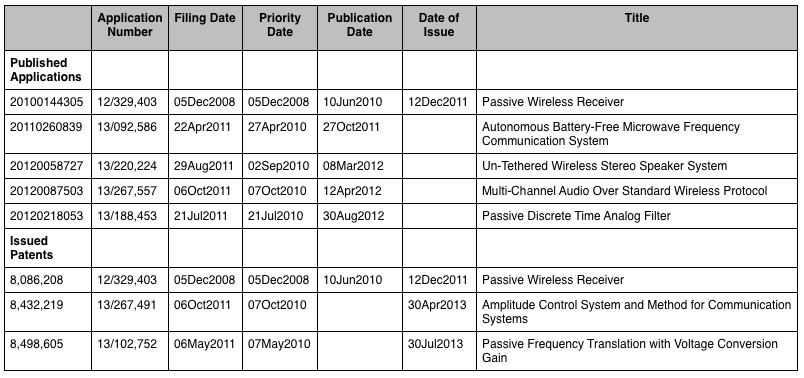what will apple do with passif?
On one level it seems this title is too simplistic. On another level it might be said that the question has already been answered. Surely, since the Passif acquisition came to light the other week there has been plenty of coverage.
Much of it has drawn a link between Passif and the iWatch, as this mythical creature has been dubbed. Here is but one example from the second round of articles. But, is it really as simple as has been presented? Is the acquisition largely about the iWatch? Is Passif’s technology largely directed to Bluetooth communications, as we might have been led to believe? Let’s think about this a bit more and see where we go.
From ned’s point of view it is always good to start with the technology, and a good place to start for this is the USPTO. What do the patent documents tell us? The table below details bibliographic information for visible patent documents at the USPTO , at the time of writing. There are three issued patents and five published applications. There is not enough room to dig into either the technology or filing details in much depth in this post, but one recurring theme emerging from the documents is the use of passive circuitry for communications.
When one thinks of an integrated circuit (IC) the vast majority of the electrical elements are active and the vast majority of these are transistors. These electrical switches are wired together in circuits of specific characteristics and designs to provide the desired functionality of the IC. The “active” moniker implies though that they consume power in both the switching operation and in a stand-by mode. A passive component in the IC, on the other hand, is not “active” and consequently consumes less power. A further discussion of these concepts is presented in, for example, the Background of US8,086,208.
The historic use of active circuitry in IC’s would be a requirement for some functionality and the required performance. Passif IP appears focused on circuit designs for communications that are built with passive components. Again turning to the Background of US8,086,208, current process technology, i.e. IC fabrication technology, may have improved to a point where the performance of passive based circuits (see col.1, lines 40-49) meets required levels. From this very basic base the issued patents assigned to Passif consider building blocks for wireless communications that should consume less power through their use of passive components. From here I do not think the discussion of Apple’s intentions for the Passif IP should be limited to Bluetooth, let alone the emerging Bluetooth LE.
But, now the more interesting question. The question that I have not seen anyone approach. How might Passif technology be integrated into Apple products? To date much of the attention of Apple circuit design has been directed at their A-series Application Processors; the A4 to A6X. These products, however, have not contained integrated “radios” for communications. Apple has used separate, 3rd party ICs for that. But, with the Passif acquisition Apple is acquiring know-how to design and further develop, at least aspects of, their own radios for communications. The next question then is whether these radio components show up in the A-series of processors, or will Apple build their own stand alone radios, or will the IP be used by 3rd parties to build proprietary radios for Apple?
Whatever the answer is to the last question Apple has branched out with the Passif acquisition. It can certainly also be said that Apple has gained low power design expertise that it might access in a host of different places. The vertical integration continues. Time will tell if this bit of circuit design will “further differentiate” their as Steve Jobs commented in April 2008 with the PA Semi acquisition.



